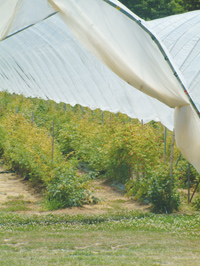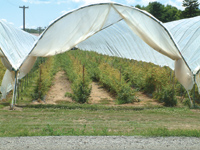
Features
Production
Research
High tunnels can extend
can extend the raspberry season
March 12, 2008 By Hugh McElhone
Research on raspberries grown
under high tunnels continues to show promise with greater yields over a
season twice as long as those grown in the field, says Mary Catherine
Heidenreich of Cornell University, N.Y.
 |
| By using high tunnels, raspberries can be protected from the elements and another two months can be added to the season, which generally ends by late September with the onset of fall rains and an eventual killer frost. The plant’s production cycle can also be manipulated through cultural practices to match the extended season. |
 |
Research on raspberries grown under high tunnels continues to show promise with greater yields over a season twice as long as those grown in the field, says Mary Catherine Heidenreich of Cornell University, N.Y.
Despite being a high value crop, the harvest of field raspberries generally ends by late September with the onset of fall rains and an eventual killer frost. By using high tunnels though, the crop can be protected from the elements and another two months added to the season. The plant’s production cycle can also be manipulated through cultural practices to match the extended season.
The test tunnel used by researchers measured 40 by 90 feet and came complete with sides that could be opened fully with hand cranks. The plastic skin was added in September long before the start of the seasonal rains, and bumblebees introduced for pollination.
Groundhogs were about the worst of the land-based vermin, says Heidenreich, and “scare eyes” were added to the peak of the tunnel at each end of the structure to ward off sparrows and other birds looking for an easy meal.
While testing the value of the high tunnel structure, researchers decided to also try some different varieties to see which ones performed best under its plastic roof.
Topping the list of the seven cultivars tested was Heritage, which Heidenreich says was a consistent performer throughout the season. Next was Josephine, which was a slow starter but eventually built steam as a solid producer as the season progressed. Caroline, on the other hand, outperformed the others at the start of the season then gradually tapered off.
Of the cultural practices used for late season fruit production, Heidenreich says the primocanes were mowed to about six to eight inches in the spring. When they reached approximately two and one-half feet high, the apical meristem, or bud, of each plant was given a soft pinch with the fingertips to delay stem elongation and budding.
They generally harvested four to six hours per day, five days per week.
As the days grew shorter and the nights colder, the structure was closed up to keep the heat in, and by November, row covers were used at night to cover the plants. “When it hit minus four degrees (Celsius) we were still okay, and the berries were very tasty,” Heidenreich said. “But when it hit minus eight, we were done.”
Overall, the season for the raspberries grown outside the tunnel lasted about six weeks while, for those grown inside, the season lasted 12 weeks. “If we didn’t have that one night of killer frost in November, the season (in the high tunnel) could have lasted another couple of weeks,” she noted.
Josephine proved to have the highest berry weight at an average of 7.1 grams per berry. This giant berry was also the winner in a taste test held among the research team. Heritage came in a distant second at 2.7 grams.
Yields in the field worked out to 2,000 pounds per acre versus 20,000 pounds
per acre for the high tunnel crop. At the peak of the raspberry season, prices hit bottom at $2 per pint but as the traditional season wound down, and local produce became difficult to find, raspberries
from the high tunnel were fetching more than $6 per pint.
One drawback to the high tunnel system is its high startup cost, notes Heidenreich. On a cost per acre basis, the structure costs $82,500, with construction at about $30,000. Rootstock was valued at $5,000, and the cost of harvest for the season came in at $53,500, for a grand total of $171,000 per acre.
The value of the raspberries harvested from the high tunnel was estimated at $134,000 per acre. With the cost of the structure amortized over five
years, Heidenreich figures this system could be operating in the black by the second year, and grossing $65,000 by year five.
Heidenreich says giving the buds a late pinch can be effective in delaying berry development until later in the season. While they did not experience any major disease problems, she hopes powdery mildew resistant varieties will be developed.
“Overall, this system shows great promise, and will allow growers to
grow beyond the traditional season,” she adds.
Print this page